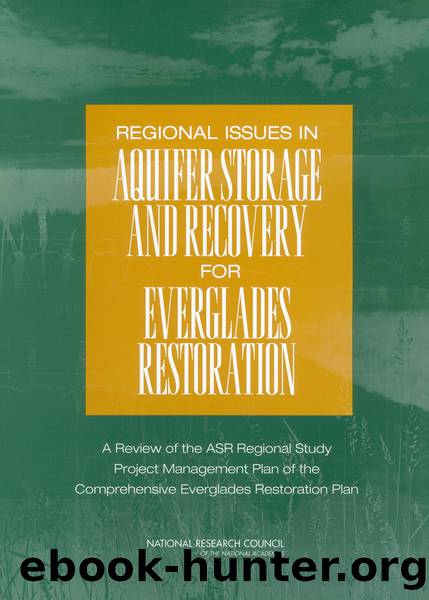REGIONAL ISSUES IN AQUIFER STORAGE AND RECOVERY FOR EVERGLADES RESTORATION by National Research Council of the National Academies

Author:National Research Council of the National Academies
Language: eng
Format: epub
Tags: Environment and Environmental Studies
Publisher: NATIONAL ACADEMY PRESS
Published: 2002-12-13T00:00:00+00:00
TASK 8âFINALIZE CONCEPTUAL HYDROGEOLOGIC FRAMEWORK
The flexible approach outlined in the description of this task is appropriate given its dependence on results of the field and laboratory programs. This task will need to be closely coordinated and integrated with the following task on regional groundwater model development.
TASK 9âREGIONAL GROUNDWATER MODELING
Construction of the regional numerical model should begin early in the time frame of the regional study, as soon as the preliminary hydrogeologic analysis is completed. Such a model could be useful in defining a framework for studying the system dynamics and in organizing field data even before calibration, prediction, and sensitivity analysis are performed (Anderson and Woessner, 1992). The PMP states that the task âRegional Model DevelopmentâPhase I" will begin in August 2003, directly following the task âDefine Preliminary Hydrogeologic Framework.â However, the text suggests that much of the initial work on the modeling will be directed towards choosing an appropriate code and developing algorithms to handle density dependent flow. Although the final model is intended to be capable of handling density-dependent flow, initial regional-scale modeling efforts employing available codes that do not have the capability to handle variable density problems may still be useful to guide the test-drilling program and associated data acquisition as well as the aquifer performance test program. This is especially true in areas with lower salinity, or where pumping-induced gradients are high. Modifications can be made to this model as the acquired data warrant in parallel with development of models with density dependent flow capabilities. Overall, the PMP outlines a reasonable strategy for developing, calibrating, testing and documenting a regional model as well as high-resolution inset models of selected areas. The Project Delivery Team recognizes the many technical challenges that will need to be addressed. It is not clear if the potential importance of horizontal anisotropy in hydraulic parameters will be evaluated, as in Yobbi (2000). Given the generic nature of the modeling task description provided in the PMP, a more substantive critique of the modeling methodology is not possible at this time. Comments relevant to the water level and water chemistry data that may provide constraints on these models are included in the discussion of Subtask 6.4. Calibration efforts should also make use of flux targets wherever possible to provide improved constraints on model parameters and boundary conditions. The Project Delivery Team should be commended for including peer review of the methodology and of the resulting model throughout the development process.
Download
This site does not store any files on its server. We only index and link to content provided by other sites. Please contact the content providers to delete copyright contents if any and email us, we'll remove relevant links or contents immediately.
| Acoustics | Bridges |
| Earthwork Design | Environmental |
| Fire Science | Highway & Traffic |
| Hydrology | Remote Sensing |
| Seismic Design | Structural |
| Structural Dynamics | Surveying & Photogrammetry |
| Transportation |
Whiskies Galore by Ian Buxton(40535)
Introduction to Aircraft Design (Cambridge Aerospace Series) by John P. Fielding(32349)
Small Unmanned Fixed-wing Aircraft Design by Andrew J. Keane Andras Sobester James P. Scanlan & András Sóbester & James P. Scanlan(32149)
Craft Beer for the Homebrewer by Michael Agnew(17464)
Turbulence by E. J. Noyes(7061)
The Complete Stick Figure Physics Tutorials by Allen Sarah(6650)
Kaplan MCAT General Chemistry Review by Kaplan(6071)
The Thirst by Nesbo Jo(5800)
Bad Blood by John Carreyrou(5784)
Learning SQL by Alan Beaulieu(5428)
Weapons of Math Destruction by Cathy O'Neil(5052)
Man-made Catastrophes and Risk Information Concealment by Dmitry Chernov & Didier Sornette(4751)
iGen by Jean M. Twenge(4708)
Digital Minimalism by Cal Newport;(4576)
Life 3.0: Being Human in the Age of Artificial Intelligence by Tegmark Max(4524)
Audition by Ryu Murakami(4108)
Electronic Devices & Circuits by Jacob Millman & Christos C. Halkias(4050)
1,001 ASVAB Practice Questions For Dummies by Powers Rod(4049)
Pale Blue Dot by Carl Sagan(4018)
